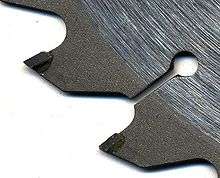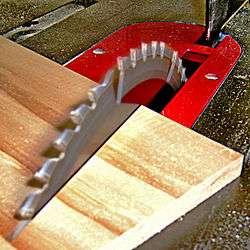Cemented carbide
Cemented carbide is a hard material used extensively as cutting tool material, as well as other industrial applications. It consists of fine particles of carbide cemented into a composite by a binder metal. Cemented carbides commonly use tungsten carbide (WC), titanium carbide (TiC), or tantalum carbide (TaC) as the aggregate. Mentions of "carbide" or "tungsten carbide" in industrial contexts usually refer to these cemented composites.

Most of the time, carbide cutters will leave a better surface finish on the part, and allow faster machining than high-speed steel or other tool steels. Carbide tools can withstand higher temperatures at the cutter-workpiece interface than standard high-speed steel tools (which is a principal reason for the faster machining). Carbide is usually superior for the cutting of tough materials such as carbon steel or stainless steel, as well as in situations where other cutting tools would wear away faster, such as high-quantity production runs.
Composition
Cemented carbides are metal matrix composites where carbide particles act as the aggregate and a metallic binder serves as the matrix (like gravel aggregate in a matrix of cement makes concrete). Its structure is thus conceptually similar to that of a grinding wheel, except that the abrasive particles are much smaller; macroscopically, the material of a carbide cutter looks homogeneous.
The process of combining the carbide particles with the binder is referred to as sintering or hot isostatic pressing (HIP). During this process, the binder eventually will be entering the liquid stage and carbide grains (much higher melting point) remain in the solid stage. As a result of this process, the binder is embedding/cementing the carbide grains and thereby creates the metal matrix composite with its distinct material properties. The naturally ductile metal binder serves to offset the characteristic brittle behavior of the carbide ceramic, thus raising its toughness and durability. By controlling various parameters, including grain size, cobalt content, dotation (e.g., alloy carbides) and carbon content, a carbide manufacturer can tailor the carbide's performance to specific applications.
The first cemented carbide developed was tungsten carbide (introduced in 1927) which uses tungsten carbide particles held together by a cobalt metal binder. Since then other cemented carbides have been developed, such as titanium carbide, which is better suited for cutting steel, and tantalum carbide, which is tougher than tungsten carbide.[1]
Physical properties
The coefficient of thermal expansion of cemented tungsten carbide is found to vary with the amount of cobalt used as a metal binder. For 5.9% of cobalt a coefficient of 4.4 µm·m−1·K−1 is found, whereas the coefficient is around 5.0 µm·m−1·K−1 for a cobalt content of 13%. Both values are only valid from 20 °C (68 °F) to 60 °C (140 °F), but more data is available from Hidnert.[2]
Applications
Inserts for metal cutting

Carbide is more expensive per unit than other typical tool materials, and it is more brittle, making it susceptible to chipping and breaking. To offset these problems, the carbide cutting tip itself is often in the form of a small insert for a larger tipped tool whose shank is made of another material, usually carbon tool steel. This gives the benefit of using carbide at the cutting interface without the high cost and brittleness of making the entire tool out of carbide. Most modern face mills use carbide inserts, as well as many lathe tools and endmills. In recent decades, though, solid-carbide endmills have also become more commonly used, wherever the application's characteristics make the pros (such as shorter cycle times) outweigh the cons (mentioned above).
Insert coatings
To increase the life of carbide tools, they are sometimes coated. Five such coatings are TiN (titanium nitride), TiC (titanium carbide), Ti(C)N (titanium carbide-nitride), TiAlN (titanium aluminium nitride) and AlTiN (aluminium titanium nitride). (Newer coatings, known as DLC (diamond-like carbon) are beginning to surface, enabling the cutting power of diamond without the unwanted chemical reaction between real diamond and iron.) Most coatings generally increase a tool's hardness and/or lubricity. A coating allows the cutting edge of a tool to cleanly pass through the material without having the material gall (stick) to it. The coating also helps to decrease the temperature associated with the cutting process and increase the life of the tool. The coating is usually deposited via thermal CVD and, for certain applications, with the mechanical PVD method. However, if the deposition is performed at too high temperature, an eta phase of a Co6W6C tertiary carbide forms at the interface between the carbide and the cobalt phase, which may lead to adhesion failure of the coating.
Inserts for mining tools
Mining and tunneling cutting tools are most often fitted with Cemented Carbide tips, the so-called "button bits". Artificial diamond can replace the cemented carbide buttons only when conditions are ideal, but as rock drilling is a tough job the Cemented Carbide button bits remain the most used type throughout the world.
Rolls for hot-roll and cold-roll applications
Since the mid-1960s, steel mills around the world have applied cemented carbide to the rolls of their rolling mills for both hot and cold rolling of tubes, bars, and flats.
Other industrial applications
This category contains a countless number of applications, but can be split into three main areas:
- Engineered components
- Wear parts
- Tools and tool blanks
Some key areas where cemented carbide components are used:
- Automotive components
- Canning tools for deep drawing of two-piece cans
- Rotary cutters for high-speed cutting of artificial fibres
- Metal forming tools for wire drawing and stamping applications
- Rings and bushings typically for bump and seal applications
- Woodworking, e.g., for sawing and planing applications
- Pump pistons for high-performance pumps (e.g., in nuclear installations)
- Nozzles, e.g., high-performance nozzles for oil drilling applications
- Roof and tail tools and components for high wear resistance
- Balls for ball bearings and ballpoint pens
Non-industrial uses
Jewellery
Tungsten carbide has become a popular material in the bridal jewellery industry, due to its extreme hardness and high resistance to scratching. Given its brittleness, it is prone to chip, crack, or shatter in jewellery applications. Once fractured, it cannot be repaired.
History
The initial development of cemented and sintered carbides occurred in Germany in the 1920s.[3] ThyssenKrupp says [in historical present tense], "Sintered tungsten carbide was developed by the "Osram study society for electrical lighting" to replace diamonds as a material for machining metal. Not having the equipment to exploit this material on an industrial scale, Osram sells the license to Krupp at the end of 1925. In 1926 Krupp brings sintered carbide onto the market under the name WIDIA (acronym for WIe DIAmant = like diamond)."[4] /ˈviːdiə/ Machinery's Handbook[3] gives the date of carbide tools' commercial introduction as 1927. Burghardt and Axelrod[5] give the date of their commercial introduction in the United States as 1928. Subsequent development occurred in various countries.[3]
Although the marketing pitch was slightly hyperbolic (carbides being not entirely equal to diamond), carbide tooling offered an improvement in cutting speeds and feeds so remarkable that, like high-speed steel had done two decades earlier, it forced machine tool designers to rethink every aspect of existing designs, with an eye toward yet more rigidity and yet better spindle bearings.
During World War II there was a tungsten shortage in Germany. It was found that tungsten in carbide cuts metal more efficiently than tungsten in high-speed steel, so to economise on the use of tungsten, carbides were used for metal cutting as much as possible.
The Widia name became a genericized trademark in various countries and languages,[4] including English (widia, /ˈwɪdiə/), although the genericized sense was never especially widespread in English ("carbide" is the normal generic term). Since 2009, the name has been revived as a brand name by Kennametal,[6] and the brand subsumes numerous popular brands of cutting tools. For the sake of clear communication, the reviving of the Widia brand may naturally further discourage use of the generic sense..
Uncoated tips brazed to their shanks were the first form. Clamped indexable inserts and today's wide variety of coatings are advances made in the decades since.[3] With every passing decade, the use of carbide has become less "special" and more ubiquitous.
Regarding fine-grained hardmetal, an attempt has been made to follow the scientific and technological steps associated with its production; this task is not easy, though, because of the restrictions placed by commercial, and in some cases research, organisations, in not publicising relevant information until long after the date of the initial work. Thus, placing data in an historical, chronological order is somewhat difficult. However, it has been possible to establish that as far back as 1929, approximately 6 years after the first patent was granted, Krupp/Osram workers had identified the positive aspects of tungsten carbide grain refinement. By 1939, they had also discovered the beneficial effects of adding a small amount of vanadium and tantalum carbide. This effectively controlled discontinuous grain growth.[7]
What was considered ‘fine’ in one decade was considered not so fine in the next. Thus, a grain size in the range 0.5–3.0 μm was considered fine in the early years, but by the 1990s, the era of the nano-crystalline material had arrived, with a grain size of 20–50 nm.
Pobedit

Pobedit (Russian: победи́т) is a sintered carbide alloy of about 90% tungsten carbide as a hard phase, and about 10% cobalt (Co) as a binder phase, with a small amount of additional carbon. It was developed in the Soviet Union in 1929, it is described as a material from which cutting tools are made. Later a number of similar alloys based on tungsten and cobalt were developed, and the name of 'pobedit' was retained for them as well.[8][9][10]
Pobedit is usually produced by powder metallurgy in the form of plates of different shapes and sizes. The manufacturing process is as follows: a fine powder of tungsten carbide (or other refractory carbide) and a fine powder of binder material such as cobalt or nickel both get intermixed and then pressed into the appropriate forms. Pressed plates are sintered at a temperature close to the melting point of the binder metal, which yields a very tight and solid substance.
The plates of this superhard alloy are applied to manufacturing of metal-cutting and drilling tools; they are usually soldered on the cutting tool tips. Heat post-treatment is not required. The pobedit inserts at the tips of drill bits are still very widespread in Russia.
See also
- Carbide Saws
References
- Childs, Thomas (2000). "A6.2 Cemented carbides and cermets". Metal Machining: Theory and Applications. Butterworth-Heinemann. pp. 388–9. ISBN 978-0-340-69159-5.
- Hidnert, Peter (January 1937). "Thermal Expansion of Cemented Tungsten Carbide". Journal of Research of the National Bureau of Standards. 18 (1): 47–52. doi:10.6028/jres.018.025.
- Machinery's Handbook (1996), p. 744.
- ThyssenKrupp AG, 1926 Krupp markets WIDIA tool metal, Essen, Germany, retrieved 2 March 2012.
- Burghardt & Axelrod 1954, p. 453.
- Widia.com, retrieved 22 October 2010.
- Spriggs, Geoffrey E. (1995). "A history of fine grained hardmetal". International Journal of Refractory Metals and Hard Materials. 13 (5): 241–255. doi:10.1016/0263-4368(95)92671-6.
- "Победит". Большая советская энциклопедия (in Russian) (3 ed.). М.: Советская энциклопедия. 1975. Retrieved 21 June 2020.
- Васильев, Н. Н.; Исаакян, О. Н.; Рогинский, Н. О.; Смолянский, Я. Б.; Сокович, В. А.; Хачатуров, Т. С. (1941). "ПОБЕДИТ". Технический железнодорожный словарь (in Russian). М.: Трансжелдориздат.
- the free dictionary: pobedit
Bibliography
- Burghardt, Henry D.; Axelrod, Aaron (1954), Machine tool operation, 2 (3rd ed.), McGraw-Hill, LCCN 52011537.CS1 maint: ref=harv (link)
- Oberg, Erik; Jones, Franklin D.; Horton, Holbrook L.; Ryffel, Henry H. (1996), Green, Robert E.; McCauley, Christopher J. (eds.), Machinery's Handbook (25th ed.), New York, NY, USA: Industrial Press, ISBN 978-0-8311-2575-2, OCLC 473691581.
External links
| Wikimedia Commons has media related to Cemented carbides. |
- Schubert, W.-D.; Lassner, E.; Böhlke, W (June 2010). "Cemented Carbides – A Success Story" (PDF). ITIA Newsletter.